Direction (1-5): The question consists of two statements numbered I and II given below it. You have to decide whether the data provided in the statements are sufficient to answer the question.
Q1. Six boxes, G through L are placed one above another where the bottommost position is 1 and the position above it is 2 and so on. Which box is placed at the bottommost position?
Statements:
I. I is placed 2nd to the above of G which is placed just above of L. One box is placed between H and K. J is placed below L.
II. Two boxes are placed between G and H. One box is placed between G and I.
(a) The data in statement I alone are sufficient to answer the question while the data in statement II alone are not sufficient to answer the question.
(b) The data in statement II alone are sufficient to answer the question while the data in statement I alone are not sufficient to answer the question.
(c) The data either in statement I alone or in statement II alone are sufficient to answer the question.
(d) The data given in statements I and II together are not sufficient to answer the question.
(e) The data in statements I and II together are necessary to answer the question.
Q2. There are six members P, Q, R, S, T and U in the family of three generations. There are couples in each generation of the family. How is P related to T?
Statements:
I. Q is mother-in-law of S who is not married to R. Q is not married to U.
II. T is the wife of R’s father. P is not the father of S who is not in 1st generation.
(a) The data in statement I alone are sufficient to answer the question, while the data in statement II alone are not sufficient to answer the question.
(b) The data in statement II alone are sufficient to answer the question, while the data in statement I alone are not sufficient to answer the question.
(c) The data either in statement I alone or in statement II alone are sufficient to answer the question.
(d) The data given in statements I and II together are not sufficient to answer the question.
(e) The data in statements I and II together are necessary to answer the question.
Q3. Five persons V, W, X, Y and Z have different heights. Who among the following is the shortest?
Statements:
I. W is shorter than only one person. X is taller than both Y and Z. V is taller than Y.
II. Z is taller than only two persons. Y is taller than W but shorter than X. W is not the shortest.
(a) The data in statement I alone are sufficient to answer the question, while the data in statement II alone are not sufficient to answer the question.
(b) The data in statement II alone are sufficient to answer the question, while the data in statement I alone are not sufficient to answer the question.
(c) The data either in statement I alone or in statement II alone are sufficient to answer the question.
(d) The data given in statements I and II together are not sufficient to answer the question.
(e) The data in statements I and II together are necessary to answer the question.
Q4. Seven persons A, B, C, D, E, F and G sit in a straight row facing north. Who sit at the extreme left end of the row?
Statements:
I. F sits immediate right of A who sits exactly in the middle of the row. G sits 2nd to the left of B.
II. A sits 3rd to the right of G. Four persons sit between D and G. B sits immediate right of C. F sits to the left of E.
(a) The data in statement I alone are sufficient to answer the question, while the data in statement II alone are not sufficient to answer the question.
(b) The data in statement II alone are sufficient to answer the question, while the data in statement I alone are not sufficient to answer the question.
(c) The data either in statement I alone or in statement II alone are sufficient to answer the question.
(d) The data given in statements I and II together are not sufficient to answer the question.
(e) The data in statements I and II together are necessary to answer the question.
Q5. Six persons Harshita, Ileana, Jessica, Komal, Lavanya and Manju have different heights. Who is the 3rd shortest person?
Statements:
I. Two persons are taller than Harshita. Jessica is not the tallest person. Neither Lavanya nor Jessica is shorter than Harshita. Komal is shorter than Ileana but not the shortest.
II. Harshita is taller than Komal. Jessica is not shorter than Ileana. Lavanya is not shorter than Manju.
(a) The data in statement I alone are sufficient to answer the question, while the data in statement II alone are not sufficient to answer the question.
(b) The data in statement II alone are sufficient to answer the question, while the data in statement I alone are not sufficient to answer the question.
(c) The data either in statement I alone or in statement II alone are sufficient to answer the question.
(d) The data given in statements I and II together are not sufficient to answer the question.
(e) The data in statements I and II together are necessary to answer the question.
Direction (6-10): The question given below consists of two statements numbered and II below them. You have to decide whether the data provided in the statements are sufficient to answer the question. Read all the statements and give answer:
Q6. Six boxes 1, 2, 3, 4, 5 and 6 are kept one above the other like a stack. The bottommost box position is A and the topmost box position is F. How many boxes are above 3?
Statements:
I. 2 is two boxes above 1. Three boxes are above 4. 5 is immediately above 3. 6 is adjacent to 1.
II. 4 is immediately above 1. Odd number of boxes are placed below 1. There are three boxes between 1 and 5. 3 is above 2, which is not below 1.
(a) The data in statement I alone are sufficient to answer the question, while the data in statement II alone are not sufficient to answer the question.
(b) The data in statement II alone are sufficient to answer the question, while the data in statement I alone are not sufficient to answer the question.
(c) The data either in statement I alone or in statement II alone are sufficient to answer the question.
(d) The data given in statements I and II together are not sufficient to answer the question.
(e) The data in statements I and II together are necessary to answer the question.
Q7. Six persons 1, 2, 3, 4, 5 and 6 are sitting on a circular table facing the center. Who among the following sits to the immediate right of 3?
Statements:
I. 1 sits second to the right of 6. 2 sits to the immediate right of 4.
II. One person sits between 3 and 5. 3 does not sit adjacent to 1. The person to the immediate left of 3 is not 6.
(a) The data in statement I alone are sufficient to answer the question, while the data in statement II alone are not sufficient to answer the question.
(b) The data in statement II alone are sufficient to answer the question, while the data in statement I alone are not sufficient to answer the question.
(c) The data either in statement I alone or in statement II alone are sufficient to answer the question.
(d) The data given in statements I and II together are not sufficient to answer the question.
(e) The data in statements I and II together are necessary to answer the question.
Q8. There are six persons namely, A, B, C, D, E and F of different ages. Who is the oldest person?
Statements:
I. B is older than only E. F is older than A who is not younger than D.
II. A is younger than at least two persons. C is not the 2nd oldest person.
(a) The data in statement I alone are sufficient to answer the question, while the data in statement II alone are not sufficient to answer the question.
(b) The data in statement II alone are sufficient to answer the question, while the data in statement I alone are not sufficient to answer the question.
(c) The data either in statement I alone or in statement II alone are sufficient to answer the question.
(d) The data given in statements I and II together are not sufficient to answer the question.
(e) The data in statements I and II together are necessary to answer the question.
Q9. There are seven members in a family which consists of three generations. Who is the mother of K?
Statements:
I. K is the only grandson of T who is married to P. P has one son and one daughter.
II. R is the son of P who is the mother-in-law of G. R is the father of K. G is a female.
(a) The data in statement I alone are sufficient to answer the question, while the data in statement II alone are not sufficient to answer the question.
(b) The data in statement II alone are sufficient to answer the question, while the data in statement I alone are not sufficient to answer the question.
(c) The data either in statement I alone or in statement II alone are sufficient to answer the question.
(d) The data given in statements I and II together are not sufficient to answer the question.
(e) The data in statements I and II together are necessary to answer the question.
Q10. Seven persons A, B, C, D, E, F, and G are living in a seven-storey building such that the bottommost floor is numbered 1 and the topmost floor is numbered as 7 but not necessarily in the same order. How many persons live between A and D?
Statements:
I. Three persons live between G and A who lives on an odd number floor above G.
II. E lives on a floor above F but below C.
(a) The data in statement I alone are sufficient to answer the question, while the data in statement II alone are not sufficient to answer the question.
(b) The data in statement II alone are sufficient to answer the question, while the data in statement I alone are not sufficient to answer the question.
(c) The data either in statement I alone or in statement II alone are sufficient to answer the question.
(d) The data given in statements I and II together are not sufficient to answer the question.
(e) The data in statements I and II together are necessary to answer the question.
Direction (11-15): The question given below consists of two statements numbered and II below them. You have to decide whether the data provided in the statements are sufficient to answer the question. Read all the statements and give answer:
Q11. Seven persons A, B, C, D, E, F and G are sitting along a row facing the north direction but not necessarily in the same order. How many persons sit between A and B?
Statements:
I. Three persons sits between G and A who sits at one of the ends of the row.
II. B sits third to the left of E who sits second to the right of G. Three persons sit between B and F.
(a) The data in statement I alone are sufficient to answer the question, while the data in statement II alone are not sufficient to answer the question.
(b) The data in statement II alone are sufficient to answer the question, while the data in statement I alone are not sufficient to answer the question.
(c) The data either in statement I alone or in statement II alone are sufficient to answer the question.
(d) The data given in statements I and II together are not sufficient to answer the question.
(e) The data in statements I and II together are necessary to answer the question.
Q12. Which statement is sufficient to find the code for ‘survivor’ in the given code language?
Statements:
I. ‘Pakistan war hero survivor’ is coded as ‘nr, da, hg, tp’
II. ‘War memorial battle Pakistan’ is coded as ‘nr, da, hg, gd.
(a) The data in statement I alone are sufficient to answer the question, while the data in statement II alone are not sufficient to answer the question.
(b) The data in statement II alone are sufficient to answer the question, while the data in statement I alone are not sufficient to answer the question.
(c) The data either in statement I alone or in statement II alone are sufficient to answer the question.
(d) The data given in statements I and II together are not sufficient to answer the question.
(e) The data in statements I and II together are necessary to answer the question.
Q13. Six persons P, Q, R, S, T and U sit in a row facing north direction. Who among the following sits at extreme right end?
Statements:
I. U sits third to the left of S and neither of them sit at extreme end. P sits immediate left of R. Q sits to the left of T.
II. Q sits second to the left of P who sits third to the left of T. R sits immediate left of S.
(a) The data in statement I alone are sufficient to answer the question, while the data in statement II alone are not sufficient to answer the question.
(b) The data in statement II alone are sufficient to answer the question, while the data in statement I alone are not sufficient to answer the question.
(c) The data either in statement I alone or in statement II alone are sufficient to answer the question.
(d) The data given in statements I and II together are not sufficient to answer the question.
(e) The data in statements I and II together are necessary to answer the question.
Q14. Six poles M, N, O, P, Q and R have different heights. Pole N is not the tallest. Which among the following pole is 2nd tallest?
Statements:
I. Two poles are taller than pole M. Pole P is taller than pole O and pole R but not than pole M.
II. Neither pole P nor pole O is the tallest. Pole M is shorter than pole N.
(a) The data in statement I alone are sufficient to answer the question, while the data in statement II alone are not sufficient to answer the question.
(b) The data in statement II alone are sufficient to answer the question, while the data in statement I alone are not sufficient to answer the question.
(c) The data either in statement I alone or in statement II alone are sufficient to answer the question.
(d) The data given in statements I and II together are not sufficient to answer the question.
(e) The data in statements I and II together are necessary to answer the question.
Q15. Five boxes V, W, X, Y and Z are kept one above another such that bottommost box is numbered as 1 above it as 2 and so on. Which among the following is topmost box?
Statements:
I. Box W is just above box Y. Box V is two boxes above box Z.
II. Box X is even numbered box. Only box W is above box Y.
(a) The data in statement I alone are sufficient to answer the question, while the data in statement II alone are not sufficient to answer the question.
(b) The data in statement II alone are sufficient to answer the question, while the data in statement I alone are not sufficient to answer the question.
(c) The data either in statement I alone or in statement II alone are sufficient to answer the question.
(d) The data given in statements I and II together are not sufficient to answer the question.
(e) The data in statements I and II together are necessary to answer the question.
Solutions
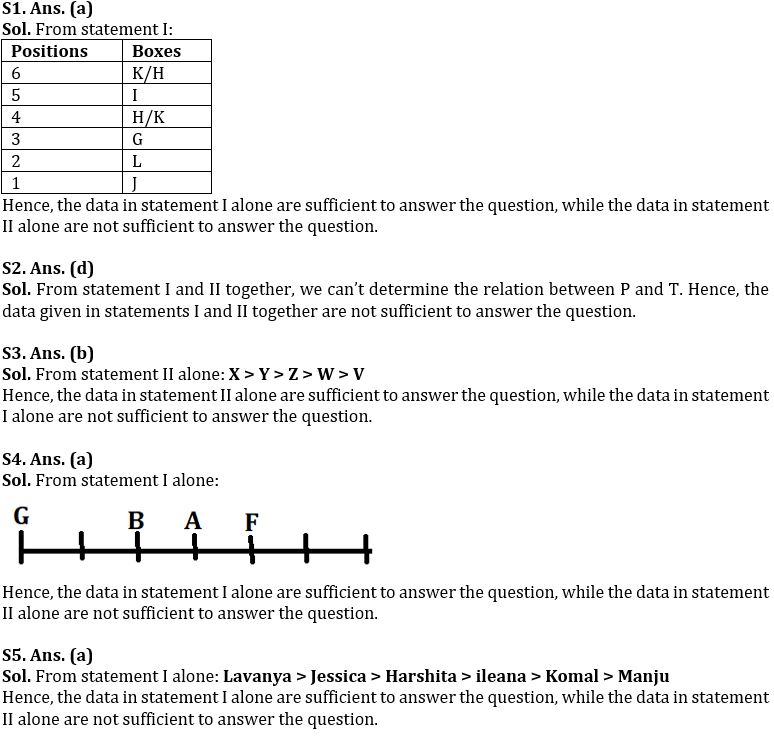
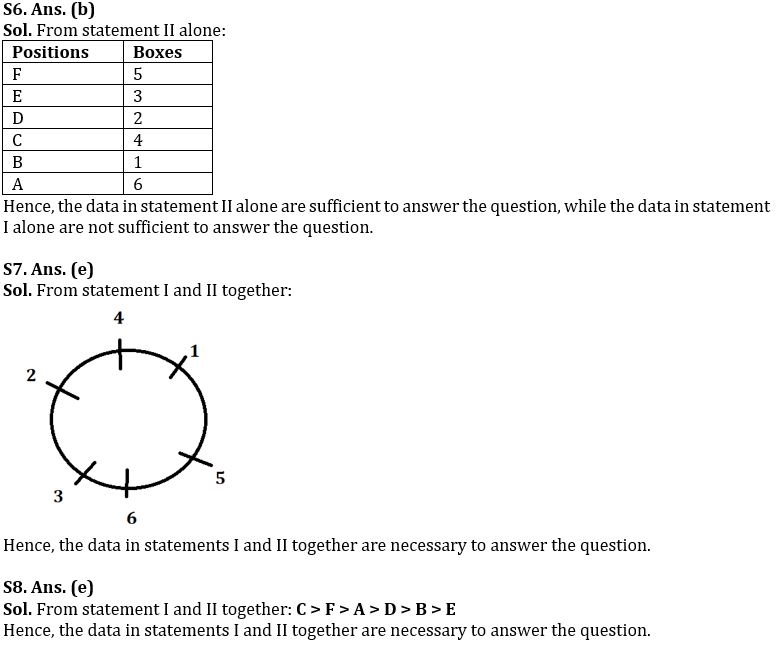
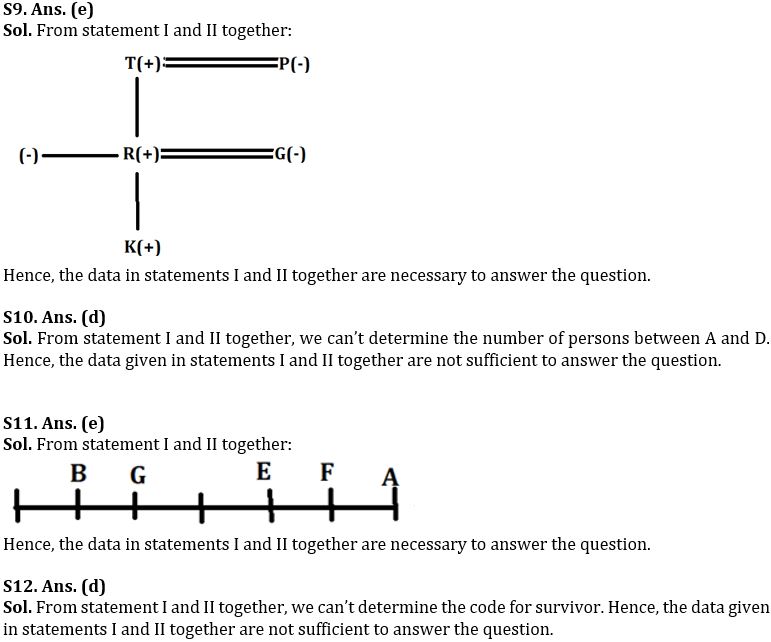
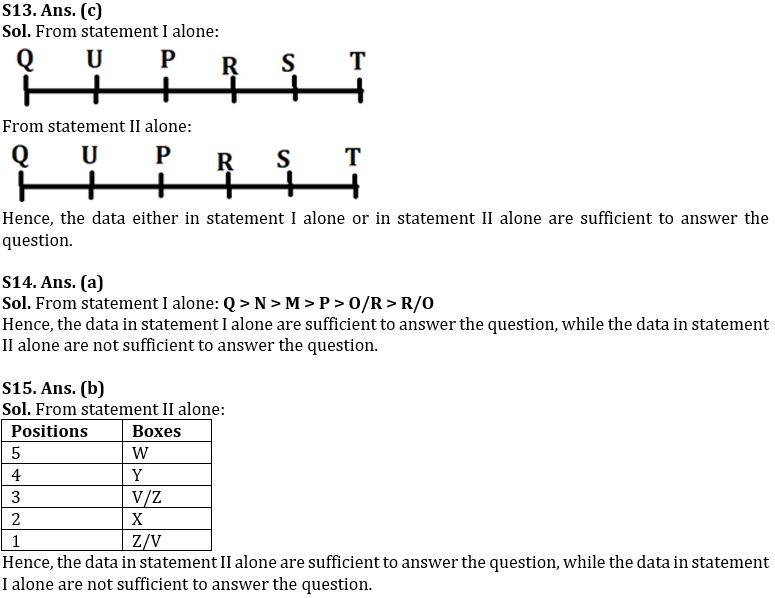



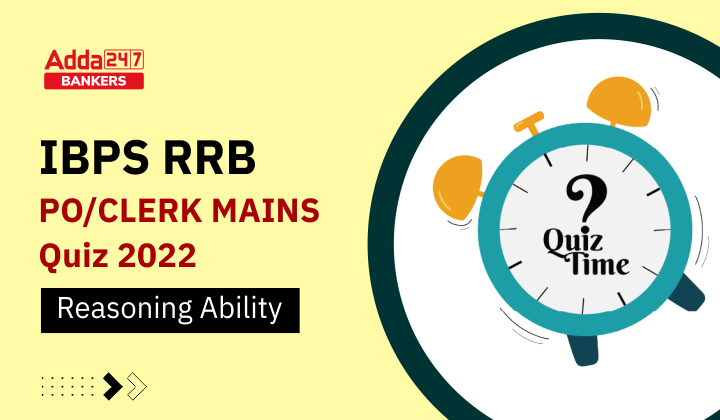

 50+ Data Sufficiency Questions For Bank ...
50+ Data Sufficiency Questions For Bank ...
 Quantitative Aptitude Quiz For Bank Main...
Quantitative Aptitude Quiz For Bank Main...





